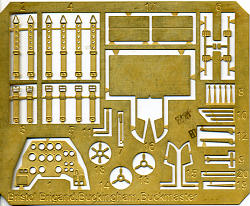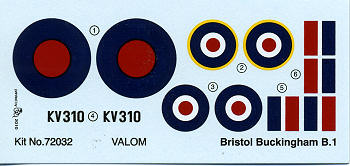
Valom 1/72 Bristol Buckingham B.I
| KIT #: | 72032 |
| PRICE: | $ |
| DECALS: | One option |
| REVIEWER: | Scott Van Aken |
| NOTES: | Short run kit with photo etch and resin parts |

| HISTORY |
In 1940, Bristol was working on a project called the Bristol Type 161 Beaumont, essentially a bomber variant of their Beaufighter. The Beaufighter itself had started as a bomber design, the Beaufort. The Beaumont never proceeded beyond the design stage.
In 1941, the new Air Ministry Specification B.2/41 called for a replacement for the Bristol Blenheim that could carry 4,000 lb (1,150 kg) of bombs on daylight raids over Germany. At the time, the RAF no longer had any medium bomber capable of carrying out daytime missions, and for this role any new design would have to have excellent performance as well as defensive armament. Bristol responded with the Buckingham B. Mk 1, powered by the new very powerful Bristol Centaurus radial engine and mounting gun installations in the nose, dorsal and ventral turrets. Generally conventional in appearance, one unusual feature was that the bomb-aimer/navigator was housed in a mid-fuselage ventral gondola. This was part of an attempt to give all the crew positions unobstructed views and access to each others positions. The bomb bay could hold a single 4,000 lb, two 2,000 lb, four 1,000 lb or six 500-lb bombs. The rear of the gondola had a hydraulically powered turret with two 0.303 Browning machine guns. The dorsal turret of Bristol's own design carried 4 Brownings. A further four fixed forward firing Brownings were controlled by the pilot.
The first flight took place on 4 February 1943.
During testing, the Buckingham exhibited poor stability which necessitated the enlargement of the twin tails along with other modifications.
By the time the design entered production, the requirements had already changed, and this sort of duty generally fell to night missions with the de Havilland Mosquito instead. However, the first batch of 119 had already been built, so after the first 54 bombers, the remainder were converted for high-speed courier duties with RAF Transport Command. The gun installations were removed and four seats and windows fitted in the fuselage. The aircraft were then designated Buckingham C. Mk I. Despite its 300 mph (480 km/h) speed and superior range to the Mosquito transports, with only room for four passengers, the Buckingham was rarely put to use. A total of 65 Buckingham bombers were unfinished on the production line and ended up re-built as the Buckmaster transport, a close derivative. The Buckmaster was also further modified for use as a trainer for the similar Brigand. Considered the "highest performance trainer in the RAF," the Buckmaster continued to serve as a trainer until its eventual retirement in the mid-1950s.
| THE KIT |
 With
its commonality to the already released
Brigand and Buckmaster, it
was only logical that Valom would also release the Buckingham. In fact, the two
wing sprues are the same on all the releases of this family of aircraft, with
only the fuselage sprue and clear sprue being different.
With
its commonality to the already released
Brigand and Buckmaster, it
was only logical that Valom would also release the Buckingham. In fact, the two
wing sprues are the same on all the releases of this family of aircraft, with
only the fuselage sprue and clear sprue being different.

You also get a photo etch fret and a bag of resin. The resin is for the two engines, which are very nicely done and far better than most can do in plastic. The etch fret is the same in all the kit and has belts, some interior bits and the fins for the torpedo (which you won't need). A clear acetate film is given for the instruments that fit behind the etched instrument panel.
The styrene is very nicely molded with superb surface
detail. The clear bits, which includes the lower fuselage gondola and upper
turret, is well molded and a bit on the thick side, distorting what you'll
see through them. One gets a nicely detailed interior with
seats, stick and pedals along with some bulkhead items. The lower forward
fuselage has some inserts as this area differs on different versions of the
aircraft though not in this boxing. Some cutting and hole drilling will be needed as well with
 Valom
providing information on those pieces. The engines are nicely
detailed and while some may wish for more, they will be partially hidden once
all is together.
Valom
providing information on those pieces. The engines are nicely
detailed and while some may wish for more, they will be partially hidden once
all is together.
Instructions are well drawn giving small detail drawings to show placement of some of the trickier assemblies. Color information is provided for a wide variety of paint brands. The lone set of markings is for an undistinguished aircraft (basically insignia and serial numbers) as the type apparently never reached squadron service. The decals are very nicely done and should work well.
| CONCLUSIONS |
Fans of RAF WWII aircraft, those who like short production planes and those who just want a nice looking model will be pleased with this one.
| REFERENCES |
http://en.wikipedia.org/wiki/Bristol_Buckingham
April 2010
My thanks to Valom at www.valom.net for the preview kit. Get yours at your local shop or on-line retailer,
If you would like your product reviewed fairly and quickly, please contact me or see other details in the Note to Contributors.